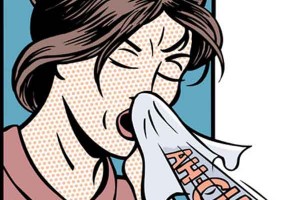I may get commissions for purchases made through links in this post.

It happens every year—the nights get longer, the days get grayer, and your spirits drop quicker than the temperature outside.
If you’re among the 20% of Americans who suffer from Seasonal Affective Disorder (SAD), you don’t have to hibernate until spring to feel better.
Here’s a list of tips that may help brighten your mood and kick the winter blues to the curb.
1. Stick To a Sleep Schedule
While your body might be begging to sleep in until noon, it’s important to keep to a defined sleep schedule (8 solid hours is best). Waking up early after a full night’s rest will help you feel less groggy in the morning and less guilty about wasting half the day in bed.
To ensure a good sleep, turn off/put away all electronic devices an hour before bed. The light from your phone or TV disrupts your circadian rhythm, making it tougher to fall asleep when you should.
If your mind is too active to drift off, try using a white noise machine, using an app, or listening to guided meditation. The gentle sounds and soothing voice is sure to lull you into dreamland so you can wake up refreshed.
2. Wake Up To Bright Light (Natural or Artificial)
Lack of exposure to sunlight is the leading cause of SAD, so make sure to soak up as many rays as you can when you first wake up. Open the blinds, pull the curtains back, or walk outside to grab the paper, anything to get you in direct sunlight.
If you have few windows, or it’s still dark out when you wake up, investing in a sunrise simulator alarm clock will be your best bet to start the morning.
- The light simulates a natural dawn by gradually getting brighter, gently luring you out of REM sleep with its glow. The effect is much more relaxing on the body than a loud, jarring traditional alarm clock, which can shock your nerves and make you feel worse as the day progresses. A sunrise alarm clock also suppresses your levels of melatonin, the chemical hormone in your body that controls sleep.
While a sunrise simulating alarm clock may work for waking you, you may also need a SAD light box (also referred to as bright light therapy lamp or blue energy light) to keep you going through the day (a wake up light made me feel a lot more cheerful and energetic but if you suffer from SAD you will probably need a SAD light box).
A study by Harvard Medical suggests that using a light box for at least 30 minutes a day first thing in the morning stimulates your brain and boosts your energy.
If you live in a place with few windows or poor sun exposure, investing in a light box will be your best bet.
Another study claims light therapy treats symptoms of SAD quicker than antidepressant medication and with fewer side effects. These light boxes are not approved by the Food and Drug Administration, however, so it’s important to do your research before purchasing one.
Bright light therapy is the recommended treatment for winter seasonal affective disorder (SAD). Source, PubMed.
Make sure that the box is specifically designed to treat SAD, as different ones (for example, boxes that treat skin cancer) emit more UV light and may damage your eyes after prolonged use.
White and blue light boxes are the most effective in treating symptoms. There are many different shapes and sizes of boxes to choose from, so find one that will be convenient for you to use daily.
3. Make Your Bed (and Don’t Get Back In It!)
Hopping out of bed and immediately fluffing the pillows and tucking in the sheets increases blood flow in the body, making you feel more alert and energized to begin the day.
Bonus: seeing a neatly-made bed will give you a sense of accomplishment, and you’ll be less inclined to mess up the blankets by crawling back in for a nap. Plus it’ll be a special treat to yourself when it’s time for bed.
4. Go For a Walk
Legally Blonde star Reese Witherspoon famously uttered the line: “Exercise gives you endorphins. Endorphins make you happy!” No truer words were ever spoken by a fictional character, so bundle up and get outside!
Take your dog for a stroll through the neighborhood, or find a great kickboxing class at your local gym. Studies show that a regular aerobic exercise routine combats depression as effectively as antidepressant medication, and the effects last longer, elevating your mood all the way to spring.
5. Eat Smarter, Feel Better
Serotonin is known as the “feel-good hormone” and is produced when the body is exposed to sunlight. During a drab winter season, producing that hormone gets difficult, but eating well-balanced meals with complex carbohydrates will give you the right nutrients to make you feel great.
During a drab winter season, eating healthy gets difficult. It seems so much easier to pop a can of Pringles and call it a day. But SAD sufferers should know that eating well-balanced meals will give you the right nutrients to make you feel great.
Lean proteins such as poultry and fish have amino acids that affect dopamine levels in your brain, causing you to feel better and have more energy to combat fatigue. Fish, specifically salmon, contain a high percentage of Omega-3 fatty acids, which studies say decreases symptoms of depression and bipolar disorder.
- Fruits such as bananas, raspberries, and blueberries fuel your brain and reduce stress in the body, making you more relaxed and mentally focused.
- Popping a multivitamin daily, especially one with extra Vitamin D, will also stabilize your energy levels and increase your good mood. As studies confirm. Vitamin D is a wonderful vitamin that helps fight depression as well as dementia and Alzheimer’s, and is naturally generated when UV rays from sunlight touches your skin. Milk, cheese, and egg yolks are loaded with the stuff, so if you can’t get your D from sunlight, add some dairy to your diet.
- Treat yourself to some rich, dark chocolate; it helps boost serotonin levels easily when eaten in moderation. Serotonin is known as the “feel-good hormone” and is produced when the body is exposed to sunlight, but chocolate makes for a sweet substitute.
6. Take a Migration Vacation
Just like the swallows of Capistrano, migrating to a warmer climate with lots of sunshine has enormous benefits to your physical and mental wellbeing. Take a weekend trip to a tropical paradise or go on a quick cruise, anything to get you in a warm, sunny environment.
Don’t stress about the cost, these days there are tons of online travel sites that will find you the best deals. Even the act of planning a trip has its benefits—who doesn’t get happy and excited looking forward to a few days in new, beautiful surroundings?
Don’t have the money? Go out first to socialize and get your daily fix of daylight after which you take a mini break at home. Indulge in binge watching your favorite TV show. Reddit for instance is a great source for TV series worth binge watching. Get some healthy snacks, snuggle up under your blanket (also to cut down on heating costs) and enjoy the darker period of the year.
7. Ease Up On the Coffee
Too much caffeine interferes with your natural circadian rhythms and can contribute to dehydration and fatigue. In fact, there are about a hundred other good reasons why you should eliminate, or at least cut back on caffeine besides beating the winter blahs.
If you can’t kick the habit cold turkey, stick to only a cup or two of coffee, tea, or soda per day, and absolutely no caffeine after 8:00pm in order for your body to have enough time to wind down and prepare for sleep.
8. Keep Your Social Calendar Full
As much as you may feel like hibernating in your home all winter, going out with friends and family will brighten your mood even on the darkest winter evening.
Going out with friends and family is guaranteed to brighten your mood even on the darkest, coldest evening. It doesn’t have to be a big event: meet a friend for coffee, invite your coworker over for dinner, or check out some local music with a group of your classmates.
Hit up a club or bar with some upbeat tunes; a study from the University of Missouri suggests that cheery music is a beneficial aid in increasing overall happiness.
9. Play that upbeat music sad boy (or girl)
The study demonstrated that listening to upbeat or cheery music significantly improved participant’s mood in both the short and long term. If you’re sad and tired already it may be a chore to find uplifting music so start creating your anti-winter blues playlists already during summer.
10. Lighten Up! (Your Home, That Is)
Bring a bit of cheer into your home with brilliant, vibrant colors and light. Red, orange, yellow, and bright white colors are said to increase your energy and creativity. Just picking a color you like seems like more sensible advice though.
Grey, blue, and purple have more calming effects, so use those colors in small doses in the bedroom to help you sleep better. Simulate springtime by putting live plants and colorful flowers throughout your home. Bringing a bit of the outdoors inside will surely perk you up.
11. Adopt Another Culture’s Happiness
Survey scores reveal that the United States ranks #14 in terms of happiness, so it may help to adopt the happiness traits of other countries when the winter is getting you down.
In Denmark, or instance, citizens have a word for the warm, happy feeling of enjoying a relaxing evening at home surrounded by loved ones: “hygge”. Tai Højer Klan, online manager at VisitDenmark, explains that “the essence of ‘hygge’ is to surround yourself in a warm, cozy atmosphere with people you care about and enjoy something you love.”
Danish folk place a lot of importance on the concept of “hygge” to connect with friends and family, but people from Sweden and Norway hold the act of connecting with nature in the highest esteem, a philosophy known in those parts as “friluftsliv”.
Those who want to experience “friluftsliv” spend a lot of time outdoors, immersing themselves in the landscape and admiring the splendor of nature, no matter the temperature. Getting outside and connecting with the natural environment will help ease a moderate case of SAD because it will give you an appreciation of the climate and elements of the cold season.
12. Create a Ritual
Whether you pick up a fancy latte on Mondays before work, or go to Bikram Yoga every weekend, creating a special ritual gives you a small, but meaningful experience you can look forward to during these dreary months.
Here’s an idea: combine this tip with tip #9 and buy yourself an inexpensive, but beautiful bouquet of your favorite flowers every Friday (or whatever day is best for you). That way you have a ritual that you can enjoy throughout the rest of the week. (Men may prefer to get a huge bloody steak, some hot pepper sauce (spicy foods containing capsaicin release endorphins) and some cold beers.)
13. Take Time to Help Others
When you can’t seem to get out of a winter rut, concentrate on helping others in order to help yourself. Several studies over the past 20 years have confirmed that volunteering a couple hours a week to help those less fortunate not only minimizes symptoms of depression, it’s been proven to lower blood pressure and increase life span up to five years longer than people who don’t volunteer.
You can find opportunities to volunteer through your local religious organization, town hall, or online at sites like Volunteering in America.
- Besides practicing giving to others there are a few more proven methods to feel happier. Make sure to avoid envy as much as possible, love yourself, and adopt that ‘attitude of gratitude’ as much as is possible in these harsh times. Even if you only manage to do so at a minimum level, these small things can help.
14. See Your Doctor
If the tips above aren’t helping you overcome SAD, or your symptoms are more serious, you should visit your primary care physician right away to determine the severity of your depression and to discuss necessary treatments and medications.
Some people with severe cases of SAD benefit from taking antidepressants, though it may take several weeks to notice its effects. Others are referred to a psychiatrist who can engage in talk therapy with the patient, assist in identifying negative thoughts and behaviors, and work to change them in order to improve the patient’s happiness.
15. Embrace the Season
While the weather may be dreary and the temperature unbearably chilly, one option to beat the winter blues is to just lean into it.
Focus on the good things winter has to offer. Snow days, toasty campfires, hot chocolate or apple cider, thick wool socks, and beautiful snowy landscapes are all wonderful things that you just can’t enjoy any other time of the year.
So keep an optimistic attitude and use the tips above and your winter will be truly merry all the way up to the last frost of the season.
- Hibernate—I know it sounds counterintuitive, but sleeping in a few extra minutes one weekend or wrapping up in a cozy blanket and zoning out in front of the TV might benefit your mood. Just make sure your nap or your Netflix session doesn’t last more than an hour, or you’ll mess up your sleep schedule and your symptoms could last longer.
- Meditate—Light some candles, find a relaxing position and close your eyes. Focus on your breathing and empty your mind of any mental chatter. Visualize yourself enjoying all the beautiful things winter has to offer, like sleigh rides, bonfires, hot apple cider or cocoa, and the silent stillness of a snowy landscape. Meditating peacefully and visualizing the winter season in a positive way may change your opinion of the season.
- Think Positive—Write down your SAD symptoms and use them to create positive affirmations (For example, if you write down “I have no motivation to do anything” your affirmation would say “I am full of energy and drive”) Repeat those affirmations to yourself out loud every day, or incorporate them into meditation. You might feel foolish at first, but eventually you will begin to actually feel the effects of the positive things you say.
Use these tips and keep an optimistic attitude and your winter blues may soon melt away.
Image by Paul Connor.























Thanks a ton for sharing your knowledge. I also feel that depression is more psychological than physical. It is a state of mind and it has to be beaten up psychologically.